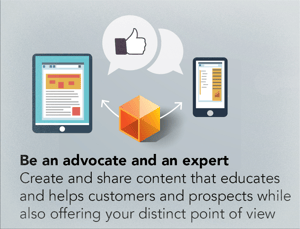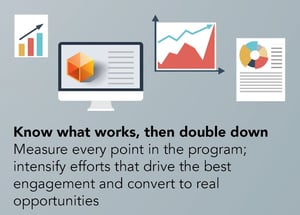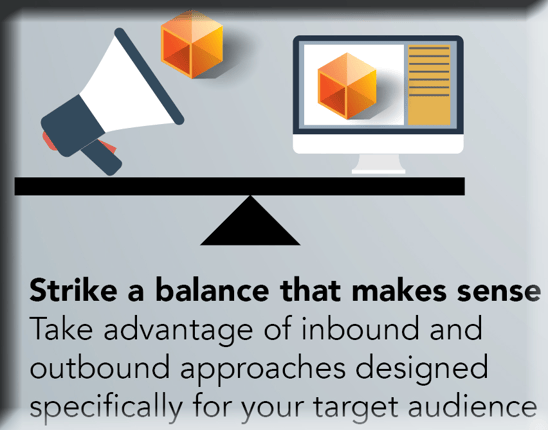Step 1: Balance
Balance. Easier said than done in the business world. Perhaps Simon Sinek sums it up best:
There is no decision that we can make that doesn't come with some sort of balance.
In my previous blog, I discussed some of the business development challenges manufacturers and technology service companies face. But how to face these challenges? Think balance. But just how do you strike a balance between inbound and outbound marketing, all tailored to your audience? It can be done.
Many of our clients often rely on acquiring business via relationship selling, referrals and word of mouth. I'll be the first to say that these are the best sales opportunities, but developing these relationships takes time and effort. A new generation of buyers do things differently and most business owners don't have the time to fully develop these relationships.
Now, I'm not saying that the traditional way of doing things is dead. Outbound efforts such as trade shows, prospecting, advertising, networking, and so on are still quite valuable. Come to think of it, when did "outbound" become a dirty word? As inbound grows, marketing professionals have been quick to jump on board and for very good reason. It works! But, why forget about those outbound efforts? Don't get unnecessarily bound to one or the other. In many cases, a more direct approach may be exactly what is needed to close a sale. Leveraging targeted trade media, shows or direct outbound calls might be the way to go.
On the other hand, what happens to those trade show leads, social media referrals and our prospecting calls that are not quite ready to buy? How do you keep in front of them? Sales is tasked with generating business and understandably will pursue the low hanging fruit. Nurturing activities tend to take a back seat to the immediate reward of a sales opportunity. Why shouldn't it? Well, in comes marketing.
The marketing department is now more responsible than ever for taking those "need to nurture" opportunities and continuing to touch them on a regular basis; not with solicitation, but with helpful content and information the respective audience needs. For example, engineers thrive on technical content and solutions, while a buyer or purchasing agent may focus on how they can save money. Why not communicate to each of them with targeted content that is meaningful to them? Relevant content increases your chances of being found via organic search or social media, and ensures a prospect will actually open your emails.
Instead of just inbound or outbound exclusively, a strategically balanced approach to demand/lead generation may be in order. In other words, the Omnibound® approach.
In Step 1 of the Omnibound approach, it's important to evaluate your both lead generation efforts and your client base. The key is to develop an understanding that will be the beginning of a plan. (This does not exclude exploring new avenues as well). Ask the following questions:
- What methods in the past have been your most effective lead sources?
- What campaigns, programs or efforts did you undertake in the past to target new business?
- Who are your clients? List industry (e.g., aerospace, healthcare, etc.), and who in aerospace or healthcare your work with.
- What are the typical challenges your prospect has on a daily basis?
- Is your prospect a Millennial? A Boomer? A person's generation influences how they find suppliers and gather information.
- Where do your prospects go to research a new supplier or product?
- Is your company visible (in the right places), providing the right information when the prospect is looking for you?
As you dive into this analysis, you'll begin to realize that the universe of information is broad. Your company must find the appropriate balance between outbound efforts and inbound efforts. The two are inextricably connected now. The challenge, however, is to determine which channels and activities make the most sense for your business. For example, we know our clients are experts in manufacturing and the industrial space but narrowing down various business development strategies and tactics is still challenging.
Our advice is to pull your team together and ask the aforementioned questions. You'll probably come up with more questions during this process. After you've put together answers, you may need a partner organization to help you achieve the inbound-outbound balance that's best for you. Interview experts in the industrial, technical and manufacturing space for this prospective partner. If a prospective partner company does not work extensively in this space, seriously consider looking for someone that does. Your value proposition is unique for industry and a full understanding of the best channels is critical. Remember, a balanced approach to demand and lead generation is key. Inbound and Outbound = Omnibound. These efforts must be fully integrated between sales and marketing to help bring your prospects down the funnel.
Step 2: Data and Systems
If you've been following the Acadia blog, you've probably detected an underlying theme...data. As with everything you do, collecting, organizing, segmenting and understanding your company's data is critical to success. I know it's getting old. "Oh brother, here goes Acadia with their data stuff again. They're starting to sound like Charlie Brown's teacher..wah, wah......wah, wah, wah."
Well, to spare you the torture, I'll lean on my favorite sport (yes it's spring training time). I promise it will be an analogy that even the most ca sual of sports fan can grasp. To set the stage, let's just say that today it's my turn to pitch. I've been having a great game so far but it's now the 8th inning of a very close contest. The tying run is at 2nd base and the opposition is bringing a pinch hitter to the plate. My manager has decided to leave me in the game but has sent out the pitching coach to talk strategy with me. That pitching coach is coming at me, armed with all kinds of information to share with my catcher and me. It might go something like this:
sual of sports fan can grasp. To set the stage, let's just say that today it's my turn to pitch. I've been having a great game so far but it's now the 8th inning of a very close contest. The tying run is at 2nd base and the opposition is bringing a pinch hitter to the plate. My manager has decided to leave me in the game but has sent out the pitching coach to talk strategy with me. That pitching coach is coming at me, armed with all kinds of information to share with my catcher and me. It might go something like this:
OK, here's the situation. This is going to be your last batter of the game, but here's what we know about him:
-
The last time you faced him two years ago, he went one for three against you. The only hit he had was on a change-up away in the strike zone.
-
His hitting chart shows that he's vulnerable to the fastball inside under his hands. He's only hitting .186 on these. When the pitch lands elsewhere, he's hitting .319.
-
We know he likes pitches away and likes to drive the ball to right field.
Armed with this information, if I execute my pitches, my chances of success are greatly increased. Of course, there are many more variables that could come into play, but you probably get the drift. Statisticians along the way have been collecting information about this hitter (think prospect), segmenting it (guys who don't like fastballs in vs. guys who do) and executing on it (delivering the right content - in this case, a fastball inside) so that we're successful.
If this information weren't available, I'd be delivering a pitch (irrelevant or weak content) with very little insight, greatly reducing my chances of success (converting a prospect to a lead). The unfortunate results might look something like....

Well, the same holds true for demand generation and lead creation. Step 2 requires
-
-
-
-
-
-
- pulling together your data,
- segmenting it,
-
-
-
-
-
- understanding your client type (persona), and
- implementing data collection and automation (e.g., HubSpot marketing automation and CRM) to ensure you're working with reliable information.
Comfortable in the knowledge that you have a strong foundation to start with (information and tools), you can begin serving the right content to the right targets. With the ability to collect and analyze data on your prospective engagements, you can modify the tactics and approaches you use. Information is the most powerful tool you have, and it drives results if implemented correctly.
As you learn from your experience, develop and execute nurturing scenarios and campaigns. They'll further your success and increase your chances of hitting it of the park or, if you're the pitcher, getting that strike out when you need it. (And when don't you?)
Step 3: Technology and Expertise
 If you've spent any time reading blogs, attending workshops or executing content-driven programs, I'm sure you've heard a key theme - present yourself as a subject matter expert in your particular area. But here's the problem: Everyone is becoming an expert. Who do you believe? Who do you follow? Who provides you with what you're looking for? It can almost be maddening. As a consumer of content on a regular basis, I love to learn. What I don't love is reading the same old blah, blah, blah. I need to learn something or I become disinterested.
If you've spent any time reading blogs, attending workshops or executing content-driven programs, I'm sure you've heard a key theme - present yourself as a subject matter expert in your particular area. But here's the problem: Everyone is becoming an expert. Who do you believe? Who do you follow? Who provides you with what you're looking for? It can almost be maddening. As a consumer of content on a regular basis, I love to learn. What I don't love is reading the same old blah, blah, blah. I need to learn something or I become disinterested.
If you've implemented a content marketing program in order tell the world that you're a subject matter expert, be careful. You can just as easily discredit yourself or your company! Hey, I worry about this too. Here I am, writing about a topic that's already been written about ad-nauseam and trying not to bore myself. Becoming a subject matter expert is worth writing about though, as it's the core of a successful sales and marketing campaign. Since Acadia's primary market focus is the industrial, manufacturing, engineering and technical space, I'll focus on this perspective.
You'd think that ideas for content in the technical space would be flowing endlessly. However, what I find instead is that most technical people feel that they actually don't have anything to 'talk' about. They feel their audience may get bored or even that they shouldn't write on technical topics because they may be proprietary or secret. Certainly there's validity to the proprietary nature of things, but that shouldn't limit your content opportunities. There are plenty of things you can write about without jeopardizing non-disclosure agreements or client confidentiality. There are also many ways to deliver this information. Let's conceptually look at different ways to view content opportunities.
- Case Studies or Examples of Work. I often hear that we don't want to put our clients information on our website or share information that could result in a stolen client. Unfortunately, this limits your opportunities as a manufacturer or technical service supplier. Remember, virtually 70% of the buying cycle is accomplished anonymously on the internet. I've mentioned in previous blogs that the demographic of our buyers are changing, and, consequently, so is the way buyer's gather and consume information. People searching for what you do need to see examples of how you do it and who you do it for. For example, pretend you are a gear manufacturer or gear cutting service. A prospect that requires specific tolerances and precision needs to see examples (text and images) of how can you meet their requirements. You don't have to give away client information, but you can ensure that by using non-specific case study titles such as "gear sets for use in precision coating applications." No client names are given away, but the application and how you accomplish it is adequately discussed. In short, be creative and look to share as much information as you can. It will help the buyer in their journey AND will help in your organic search as well.
- Gated Content. What does this mean? Say you want to know who's viewing your website but your analytics are showing things like att.net, comcast.com or other internet service providers. You know that these domains aren't interested in your technical or manufacturing products but you do know that someone out there is searching for what you do. They might be using a tablet, phone, home computer or even a work computer that you analytics program couldn't discern. So, how do we get them to tell us who they are? The answer could be gated content. In other words, an ebook, white paper, lookbook or other compelling "offer" that a prospect is willing to fork over their name in exchange for. Your content must be compelling and relevant in order for a prospect to give up that name! No one is going to "pay" for a simple sales brochure, but a prospect might be compelled to exchange information for a white paper titled "5 Design Tips to Maximize Your Sheet Utilization in Stamping Applications." An engineer would be very interested this type of information, and yes, it just happens to have your brand as the author. How about "5 Ways to Save 10% in Sheet Metal Consumption by Maximizing Sheet Utilization?" A purchasing agent would certainly be compelled to download this. Gated content must be useful and meaningful in order to get the prospect to pay. Be creative and think of topics that would be interesting to you. What would you pay for?
- Integrated Awareness Campaign. The 'old school' way of doing things isn't dead, but we can sure be smarter about it. As a B2B company in the technical space, you have lots of meaningful information to share. So yes, speaking to people is critical. Arrange to speak at trade events, or even engage a company to perform outbound efforts on your behalf. We're not talking telemarketing, but actual inside sales. Even consider delivering to targets' desks, in a very targeted and strategic fashion, a technical brief with a follow-up by your inside sales group. "Hi, my name is Bob and I'm calling from Acme. I wanted to follow up on the 'sheet metal utilization savings tips' technical brief we sent over, and see if you've had a chance to review it." Now you're sharing content and having a conversation. Integrate these efforts into your marketing automation platform to continue to nurture your prospective client. In our world, a conversation is always required at some point in the engagement, and a carefully planned and integrated inbound and outbound approach can help you accelerate the sales process. But remember, share information, don't sell.
There are many other content and information sharing opportunities available through many different channels. But the key is that you are the subject matter expert. In our world of manufacturing, technology and industrial solutions, there's so much expertise that you, the supplier, has to offer. Why not share it and become that expert?
Step 4: Measure, Rinse, Repeat
 As we progressed down the first 3 steps of this journey of demand generation, we discussed the importance of striking the right balance for your specific business development needs, managing data and systems and ultimately creation of compelling content. In other words there is no prescription for demand generation. It is about processes, systems and execution. Sound's a lot like manufacturing, doesn't it? Being and electrical engineer myself, this concept appeals to me. No one should be telling you that a new website and inbound program is all you need. On the flip side, outbound calling or outbound marketing efforts may not be the only solution. Careful evaluation of your historical efforts, balanced with how the market is changing and how people look for you, is the mindset you should take, especially as you evaluate your next steps. It is highly recommended to solicit input from colleagues and professionals in the industry to help you understand what strategies and tactics are available.
As we progressed down the first 3 steps of this journey of demand generation, we discussed the importance of striking the right balance for your specific business development needs, managing data and systems and ultimately creation of compelling content. In other words there is no prescription for demand generation. It is about processes, systems and execution. Sound's a lot like manufacturing, doesn't it? Being and electrical engineer myself, this concept appeals to me. No one should be telling you that a new website and inbound program is all you need. On the flip side, outbound calling or outbound marketing efforts may not be the only solution. Careful evaluation of your historical efforts, balanced with how the market is changing and how people look for you, is the mindset you should take, especially as you evaluate your next steps. It is highly recommended to solicit input from colleagues and professionals in the industry to help you understand what strategies and tactics are available.
Having done this you now you believe you have a good starting point, you've done your research and you are prepared to embark on a program that deploys multiple market channels and efforts. You've come to realize that the approach is multi-dimensional. Not Inbound only, not Outbound only but rather Omnibound - multi-directional and multi-faceted.
Well now that you are ready to move, you'd better have systems in place to track and capture all the information and organize your data. Think about running your factory or manufacturing processes. You are required by your clients to prove that you have validated quality systems to measure and track your product and process quality. You may even be required to have ISO certification or another industry specific certification. Why shouldn't your marketing and sales people be expected to have the same systems in place? These systems do exist, whether in the form of CRM or marketing automation tools. Evaluate and deploy these systems as part of your plan. You won't be sorry.
Well, you have the plan and the systems in place. Now you need to manufacture your product. Think of that product as not only what you do, but how you do it and who you do it for. Tell the world and let them know that you ARE the expert in your particular space. You have a lot to share and showing the market that you are that expert is critical. This is where the right content cannot be underestimated. Not just any old content, but eBooks, white papers, case studies and communication that you deliver in many different ways. Via your website, at a trade show or even during a sales call. Because Acadia deals in the technology space, we know our clients have so much to share. It is a matter of discipline to make the time to let your expertise be known. You may need help to accomplish this but evaluating vendors to help you with these efforts is important. No different than evaluating a parts supplier. They must know what you do, understand your processes and business in order to serve you. Do not forget how critical it is to 'speak' to your expertise. You cannot forget this part of the journey.
Everything you've put in place leads to the final step. Measure, Rinse and Repeat. Remember where I equated understanding your data to a baseball analogy to make my point. If I don't understand my data and know how to use it, bad things could happen. Well, you've been collecting data in all your systems. Taking that data and putting it together to make meaningful change is what makes this all tick. Suppose you kept making a part over and over and never measured it over the course of time. You would never know that a cutting tool might be in need of sharpening or a gauge is in need of calibration. Without using the data in a meaningful fashion, you would not be able to make an appropriate process change. Well, the same holds true for Sales and Marketing. This data can help you refine your sales process and marketing efforts, help you target better and close at a higher rate. Make sure you are looking at data points like:
Well, you've been collecting data in all your systems. Taking that data and putting it together to make meaningful change is what makes this all tick. Suppose you kept making a part over and over and never measured it over the course of time. You would never know that a cutting tool might be in need of sharpening or a gauge is in need of calibration. Without using the data in a meaningful fashion, you would not be able to make an appropriate process change. Well, the same holds true for Sales and Marketing. This data can help you refine your sales process and marketing efforts, help you target better and close at a higher rate. Make sure you are looking at data points like:
- Where are you getting your leads?
- What lead sources are working best for you?
- What lead sources provide the best leads, not just quantity, but quality?
- What journey does the prospect take to get to you?
- Does that journey tell you something about where they are in the buying cycle?
- How long does it take to close a lead to business?
- What is the cost of acquisition for sales and a lead?
- What is the overall cost of sales?
- Where am I in the sales funnel?
- How much will I close in the next 'X' months?
- What is the overall value of my sales pipeline?
- For every sales and marketing dollar I spend, how much do I get out the other side?
The list can go on and on, but the last point is ultimately your goal. If you knew that for every $1 into the process, I could generate $3.25 out the other side, why not invest more? Guess what, those tools now exist as does the process to accomplish this. Think like a manufacturer would. How do I produce what I make most efficiently and how do I make the most money? You measure everything. Why not do it for your demand generation, after all, this is the life blood of your business. Revenue performance management is what it is all about, be it in production or in business development.








Comments